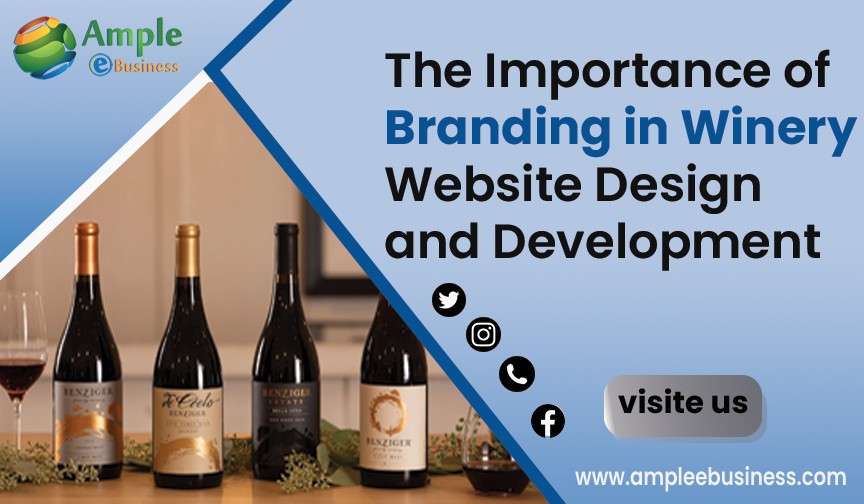
Even if you have a stunning vineyard, excellent wine, and a lavish tasting room, your brand’s revenue will suffer if your website is a failure. Nowadays, the majority of people will learn about your winery through your website. It may not be possible for tourists looking up “wine” online to rely on word-of-mouth recommendations to get past a poor first impression, so visual appeal and brand representation on your website is crucial.
Many potential customers won’t even be aware that your brand exists without a good winery website design unless they happen to see it at a trade show or get a recommendation from a friend.
A life spent ambling through the vineyards and sipping your most recent vintage is suggested by starting and running a winery. But managing a winery is a labor of love that calls for expertise and passion. An effective website can serve as your online sales representative to help with the winery business. For tips on how to make your website work for you, keep reading.
1) How to make your homepage stand out?
A potential or returning customer’s first impression of your winery will be formed by your homepage or landing page. If the content and design of that page do not grab the visitor’s attention right away, their time on your website will be limited. The viewer must be drawn in and engaged by the layout of your homepage. The page’s format and content should encourage visitors to stay put. To ensure that your message is consistent, your website’s design should reflect your branding. Showcase your brand by displaying it in your logo, the winery, and your products. Use typefaces and hues on your website that go well with the labels on your wine bottles.
Your landing page’s graphics should eloquently convey the history of your winery. Showcase the unique qualities that set your winery and products apart from those of your rivals. You want a relaxed and welcoming collection of graphics if your winery is informal. Your homepage must reflect the principles of your brand. Make sure you comprehend your target market and clients. You can use this to assist in designing. Our story, the facts, location/hours, merchandise, events, and buyers’ club should all be part of a website’s foundation. Think about incorporating a blog and/or a newsletter into your website or other social media platforms.
2) Explicit Storytelling
Your website’s home page should include a link to your story. Consider beginning with the earliest stages of the winery’s concept. The journey of your winery should be humanized. Link to how the vision for the brands and varieties of wines you produce and sell was shaped by the path you took to start or buy the winery. Concentrate on what distinguishes you, your brand, and your winery. This tale ought to enhance or create the market niche that you hold. People have been telling stories as a part of the human experience since the beginning of time. We communicate with one another through stories. Each of us adds one or two chapters to the overall narrative of our humanity.
3) Using images and video
While words are a crucial component of your website, they must be supported and improved by images. On your website, post images and videos that will engage your visitors. Describe the vineyard’s views:
• Harvest period
• Videos showing the production of wine
• If you have one, pictures of the tasting room
• Photos of activities that took place at your winery
• The wine labels designed for you
• Your wine cellar in pictures
• Copy written to introduce your winery and products
Customers’ purchasing decisions are influenced by branding and labeling. Bring your brand to life by combining various artistic mediums.
4) Freshen up your content
Your website needs to be updated frequently with new content if you want visitors to come back. Your website should feature any new wines. Giving information about the wine’s composition when you introduce a new wine will encourage customers to buy the newest member of your line. Include suggestions for dishes that go well with the wine. Customers are invited to a wine tasting.
Don’t forget to inform website visitors about upcoming winery events. The inclusion of various seasonal activities will encourage year-round customer visits. When customers are looking for something to do, you want them to go to your website. Being renowned as a winery with dynamic events will keep attracting viewers.
Think about including a blog on your website. With a blog, you must, however, make a commitment to posting frequently. Informational postings about wines, in general, may be among these updates. By showcasing your own products, you can conclude the posts. Wine storage, the best glasses to serve wine in, and other topics can be covered in blog posts. Make a list of questions that both new and seasoned wine enthusiasts might have. Use this list to generate blog posts that you can publish once a week at the very least. Through your blog, you can ask your customers for feedback. By doing this, you’ll improve your interactions with customers and create a devoted following of wine drinkers. Adapt your website consistently to the needs of your visitors.
5) Shop with ease
The purpose of a successful website is to boost sales. Customers’ purchases of wine in cases or bottles should be included in this. Tickets to winery events could also be included. Maybe you’ll grow your company and add complementary products. On each page of your website, a clear link to making purchases available is what you want. Pages that offer products for purchase ought to have a clearly marked button to start shopping. Make sure the shopping cart is always visible for customers on your website when they switch screens. Each of your other pages should have a clear view of the cart or buy button.
6) Access and Formatting for Mobile
The way of life we lead today encourages mobility. Your website must be easily reachable from a phone due to the widespread use of smartphones for communication, shopping, reading news, and other purposes. A website’s pages should be designed or updated so that they can accommodate the size and capabilities of mobile devices. The ability of customers to easily navigate your website—often referred to as the user experience or UX—is essential to generating sales. Your website must be designed so that visitors can easily navigate from one page to another. Customers should be able to navigate between pages without losing their place if they start a shopping cart and then want to view your tasting room hours.
A few helpful hints for your website
1) Your website should be responsive
Nowadays, mobile devices account for more than 60% of searches. A company cannot afford to lose out on half of the potential customers who are actively searching for them.
2) Putting content marketing first
Inform your customers about new products, production techniques, food pairings, and impending promotions. Promote and distribute user-generated content on your website and social media platforms.
3) Spend money on branding and design
Building a strong brand identity is always worthwhile, regardless of how long you have been in the wine industry. A professionally designed website attracts new customers and reflects your company’s history, quality, and passion.
4) Utilise social media
Make as many connections and interactions with your visitors as you can. Use social media to get in touch with them. Repurpose your content for various target markets and formats.
5) Present a social case
Real-person reviews are trusted by consumers. Display positive customer feedback on your website. Encourage them to share their story on their preferred social platform with the hashtags you suggest.
6) Invest in an online store platform
Small wineries can find new customers and an additional source of income by using a direct-to-customer sales strategy. It can be a useful tool for testing the market and promoting new products before they are formally introduced, provided it is used carefully.
7) Provide an online tour
Use virtual tours to showcase your facility and draw in customers. The cost of making a virtual tour has significantly decreased. You can even do it yourself with a reasonably priced 360-degree camera and virtual services like Matterport.
8) Use only top-notch images and videos
Do not skimp on the pictures (and videos, if you can). Think about including a gallery of your vineyard, surroundings, goods, and staff.
Branding Integration on Websites
The need to share your brand identity online through your website has arisen as a result of the pervasive use of the internet. This is your calling card and, most frequently, the client’s first contact with your business. A strong brand communicates values that customers value and builds a personal connection with visitors in addition to converting leads into customers. You can attract a tonne of devoted customers if you combine this with first-rate customer service.
From the planning stages through content creation and your marketing initiatives, branding should be an integral part of the process when you build and design your website. Your website must accurately represent who you are, what you stand for, and why you attract loyal customers. Your web design should incorporate branding to ensure consistency, which supports authenticity. This strategy includes integrated engagement tools like your social media pages, blogs, and vlogs. Across all platforms, it’s crucial to maintain consistency and promote a unified brand identity.
It can be difficult to establish your company’s brand identity, but integrating branding with your website is a crucial step that can significantly improve your efforts.
Wine & Winery Websites at Ample eBusiness Contain:
• Appealing design that is specific to your brand
• User-friendly and simple-to-use layouts
• Fully implementing search engine optimization techniques
• Facebook, Twitter, and Google+ are some basic social media links.
• Includes Google Analytics for regulating website traffic.
Features of websites for wineries:
• Promote your brand and the character of your winery.
• Details about the venue and the wine tasting are prominently displayed.
• Promote events, special offers, and any wine sales on product pages with images, tasting notes, and release information.
• Display accolades, positive reviews, and other noteworthy information.
If you have any questions about our services, don’t hesitate to get in touch with us.

